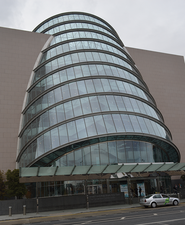In the halls at LinuxCon Europe 2015
Penguins in Dublin

© Photos by Richard Ibbotson
This year's LinuxCon Europe brought Linux users and developers to Dublin, Ireland, for keynotes, technical talks, and lots of memorable community moments.
The LinuxCon caravan moved to the Dublin Convention Center on October 5-7, 2015, for LinuxCon Europe 2015. This year's conference was probably one of the best GNU/Linux international events of 2015. The keynote speeches and conference presentations were excellent, and the conference covered a broad spectrum of important Linux topics. In addition to the main LinuxCon show, visitors could look in on the co-located CloudOpen conference or the ifelc embedded Linux conference without leaving the building. The Dublin conference center is one of the best in the world and quite a good advertisement for Dublin and for Ireland itself.
First Day
We ran through the pouring rain for the first keynote. The proceedings kicked off with Jim Zemlin giving his usual cheerful introduction to the conference. Jim introduced Sean Gourley for his talk on high-frequency trading and the rise of the algorithm. Gourley gave a fascinating account of how artificial intelligence is used to run complex systems like the New York Stock Exchange. Gourley, who was originally from New Zealand, is now based in San Francisco, where he splits his time between mathematical research and his venture-backed startup Quid, which he co-founded in 2009. His academic research has taken him from nanotechnology to complex systems and the mathematics of war, and, as a result of his research, he has acted as a political advisor to the US military and the Iraqi Government. In his keynote presentation, "Man vs. Machine: High Frequency Trading and the Rise of the Algorithm," he discussed the limitations of human mental capacity, describing what the brain can and can't do and how software developers can exploit this knowledge to explore niche markets.
Stefanie Chiras, Director for Scale-Out Power Systems for IBM, spoke on "Trading for the Digital Economy with Open Technology." Chiras showed that new computing models and workloads from cloud to big data and analytics to mobile and social platforms are transforming information technology. Linux, OpenStack, Docker, and other open technology projects are at the center of many of these innovations.
[...]
Buy this article as PDF
(incl. VAT)
